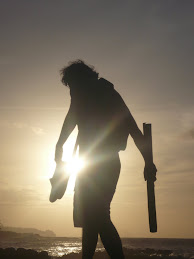 HOW'S DA HAWAIIAN T-SHIRT DEEP IN MONGOLIA!?!
HOW'S DA HAWAIIAN T-SHIRT DEEP IN MONGOLIA!?!HOE WA'A BABY
Nadaam celebrations and competitions continue for the rest of the soum. Most shops are closed while they enjoy their holiday. We decide to take it easy and give our bodies some much-needed rest. Our schedule has been evolving daily, and once things start rolling, we don’t know when the next opportunity for a full rest day may come.
A quick visit to the hyrdo-electric station on the river just outside of town which provides electricity for 10,000 people during the summer. When the river freezes over, there is no electricity for the soum. The water at the base of the small spillover dam, perhaps two meters high, is churning with small fish trying to leap up the embankment - so thick that you can fish them out, grizzly-bear style with our bear hands. [zing! =p]
Appropriate Technology.
Fantastic that the community is using a renewable source of energy. Perhaps wind or solar may have been a better choice? Most gers out on the steppe are equipped with small solar panels to power lights and even satellite televisions inside, but there is a noticable absence of wind generators.
First shower since we left Ulanbaataar! …a public bath house costructed during Socialism times with a pipe coming in from the boiler room housed in a wooden shack in the courtyard. 2,500MNT gets you thirty minutes of hot water in a shower stall the size of my first apartment. Best. Shower EVER.
Catch up day on audio / visual. It takes at least an hour at the end of each day to dowload, log, and sort all the photos taken, and write the daily journal entry. Then it takes about another hour to edit together a short clip for our daily video log, which I am now shooting on my mobile phone camera because it would suck too much time and electricity to log, capture, and edit footage from The Program Director's video camera into our daily video entry.
Research continues. A walk around the compund where the PDC will be held, identifying opportunities to improve existing design in the compound, identifying opportunities to create design appropriate and replicable design strategies that will be easily transferred to a nomadic herder’s context. No sense teaching strategies that will only work inside a walled compund when our students live out on the steppe.
Question of the day:
How appropriate is it to teach a culture that has adapted to eating meat and dairy over thousands of years to grow vegetables?


No comments:
Post a Comment